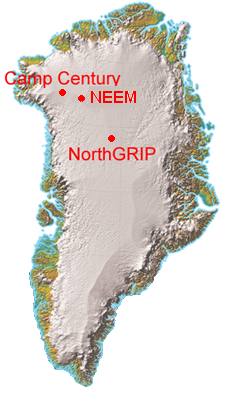The NEEM ice coring project

The need for the NEEM ice core
Before the drilling of the NEEM ice core none of the deep ice cores from Greenland (Camp Century, DYE-3, GRIP, GRIP2, or NGRIP) contained complete and undisturbed layers from the Eemian, because the layers had either melted or have been disturbed by ice flow close to the bedrock.
Greenland temperatures were about 3-5°C warmer higher than present during the Eemian, making the Eemian a useful analogue to the future climate, which due to global warming is projected to warm by 2-4°C per century. By understanding how the Eemian climate evolved, we can improve our ability to make projections for how our current climate will evolve in the future.
The NEEM drill site
The choice of drill site was based on criteria giving the best possible conditions for retrieving the old Eemian ice:
- The ice must be thick, as large ice thickness implies more annual layers.
- The bedrock most be flat, because uneven bedrock causes irregular ice flow that can distrub the ice layering
- The precipitation should be moderately high. Large annual snowfall results in fast ice flow and thereby fast thinning of the lower, older parts. In contrast, low snowfall will mean that the annual layers become harder to detect and analyse.
- The dril site should be on an ice divide. The ice divide is the line that separates the east-flowing part from the west-flowing part. The oldest ice layers are found near ice divides.
The NEEM drill site was chosen based on radar profiling of the ice internal layers and the bedrock topography. The measurements showed an ice thickness is close to 2542 m.
Field work
The former Centre for Ice and Climate coordinated the NEEM project and managed the logistical efforts needed to meet the logistical challenge of operating on the Greenland ice sheet.
The project started in 2007, when 2 tracked vehicles dragged equipment from the previous drill site, NGRIP, to the NEEM drill site. The camp is being built in 2008, where the drilling also began. The majority of the ice core drilling took place during the summers of 2009-2012, during which the camp accommodated about 30 researchers and technicians for 3-4 months.
Analyzing the ice
Understanding the dynamics of the climate system was the main objective of the extensive analysis program, which involves many different types of measurements:
- the isotope ratios of the ice reveal past temperatures in Greenland and at the source areas that supply the moisture that ends up as precipitation over the ice sheet
- impurities in the ice reflect the impurity load of the atmosphere of the past
- gas bubbles trapped between the snow crystals contain samples of the atmosphere of the past, reflecting the atmospheric composition, e.g. the amount of greenhouse gasses
- the crystal structure of ice, the temperature of the bore hole, and the content of biological material in also provide information about past climatic conditions
The analysis of the more than 2½ km ice core was performed at the former Centre for Ice and Climate with cooperating research groups from 13 nations.
The study of ice cores can thus both improve our understanding of the history of our climate and improve our ability to make good projections of future climate.

